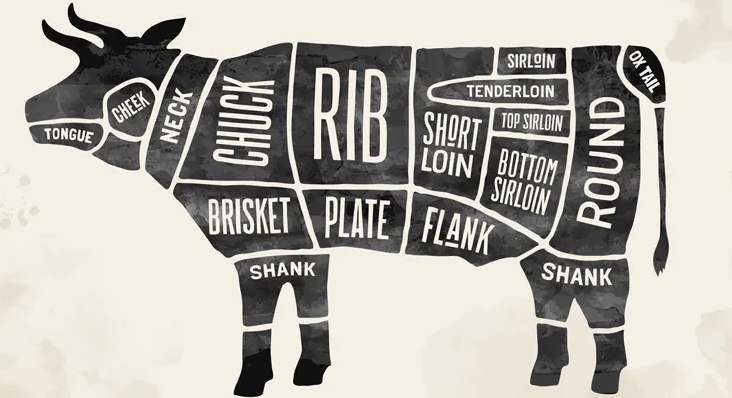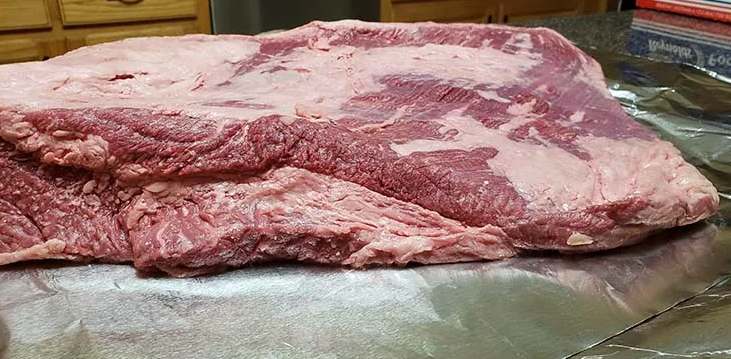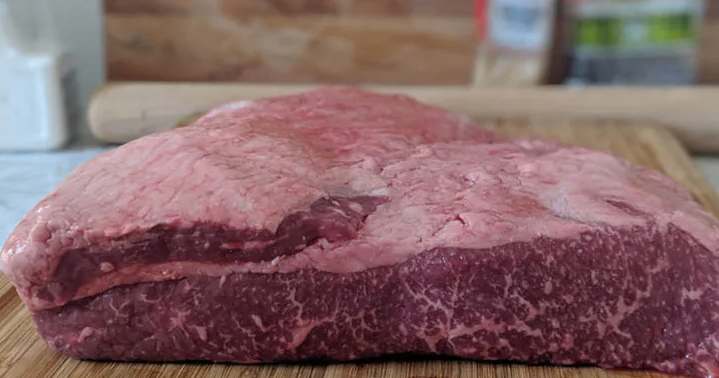Ever wonder what exactly is brisket?
Chances are if you’re into barbecue you’re familiar with the popular staples.
Pulled pork and smoked chicken quarters are pretty self-explanatory, but not everyone – and especially those unfamiliar with Texas barbecue – is as familiar with brisket.
If you’ve had pastrami or corned beef, you’ve basically had brisket.
When cooked correctly, there are few meals in the world that yield such a rewarding and succulent result, but it takes time, effort and care to get that magic to happen.
We’ll walk you through what part of the cow brisket is from, how to buy one and some of the best ways to cook brisket.
What makes brisket special?
Brisket is a tough piece of meat.
That being said, when done low and slow, brisket renders soft and satisfying with immense flavor. Cooking low and slow breaks down the collagen in the connective muscle tissues to achieve tenderness.
You can get great results cooking brisket whether you smoke, braise or slow roast. Since we’re all about barbecue here, we will focus on how to slow smoke your brisket to give you added depth of flavor from the wood.
What part of the cow is brisket?
Brisket is actually two overlapping muscles from the breast or lower chest of beef or veal. This muscle does all the heavy lifting in terms of holding the cow upright.
It is one of nine beef primal cuts.

Brisket gets very dense from being a working pair of muscles and is one of the least tender parts of beef you can get.
A whole or “packer” brisket is made up of a lean point cut and the fattier flat cut.
Smoking your brisket
When you get down to it, smoking a brisket is pretty straightforward. Below is a brief overview of the process. For a more in-depth look, see our guide for smoking your first brisket.
- Prep your smoker to 225 – 250 degrees. Use hardwoods like oak, hickory, or whatever are native and accessible to your region
- Trim your brisket – Check out HeyGrillHey’s guide on how to trim a brisket.
- Season or rub the brisket – This can be as simple as kosher salt and coarse ground pepper, or as complex as adding a binder like mustard with a more complex rub blend.
- Smoke your brisket – For this initial stage, place your brisket on the rack fat side up, and do not open the cooker. Keep it closed and steady for 3 to 4 hours to really let the bark form from your seasoning or rub.
- Spritz your brisket – Once an hour for the next 5 – 7 hours. This is an optional step but is recommended to keep the surface from charring, add moisture and add a subtle depth of flavor if you are using a liquid like an apple juice or Worcestershire sauce.
- Wrap your brisket – Then place it back on the smoker. Check out our guide for wrapping brisket.
- Keep Smoking – you know you’re close to done when the internal temperature of the meat reads 200 – 205 degrees in the thickest part.
- Rest your Brisket – Pull your brisket and let it rest for at least 1 hour to reabsorb the juices. You can let it rest in an insulated cooler for hot holding until you’re ready to serve your guests.
- Slice and serve – Check out Texas Monthly’s guide to slicing brisket.
Other brisket recipes
There are plenty of other methods for cooking brisket, not just smoking.
Let’s explore some other tried and true brisket recipes:
- Red Wine Braised Brisket – Slow-braised brisket in red wine and vegetables
- Texas-style Oven Brisket – Dry rubbed brisket roasted in the oven over a water bath with liquid smoke. A great option for those without smokers.
- InstantPot Korean-chili Brisket – Set-it-forget-it style cooking option with exotic Korean flavors.
If you want to take it up a notch and get into the curing game, check out these recipes below:
- Corned Beef Brisket – Beef brisket that has been preserved through a brine curing process similar to pickling. Traditionally from Irish and Jewish cuisine.
- Pastrami – Cured similarly to corned beef, but cooked on a smoker adding another layer of flavor to the final product
What are the different cuts of brisket?
Brisket typically comes in three cuts: full packer, the flat, and the point. Each cut has its own unique features and appeals.
Full Packer

This cut is both the flat portion and the point portion of the brisket separated by a thick layer of fat. This can weigh anywhere from roughly 8 – 20 plus pounds on average.
A layer of fat runs along the top. This fat is usually trimmed to a quarter of an inch thickness before cooking.
The Flat

The flat is the lean, main part of the brisket. It can be referred to as the first cut, or flat cut when ordering from your butcher.
It is a highly worked muscle, resulting in its low-fat content. This is generally the cut used for corned beef and pastrami.
The Point
The point is the fatty end of the brisket. It sits atop the flat and has much more intramuscular fat than its counterpart.
Given it’s high fat content, this cut makes for a more tender and juicy part of the brisket. Also referred to as the second cut.
Tips for buying and storing beef brisket
Brisket has come into high-demand in recent years, especially since fast-casual restaurant chains are getting in on the brisket game.
This popularity makes it easier to find in your local grocery store, but also hikes up the price per pound.
Whenever possible, check out your local farmers, farmer’s markets and butcher stores.
These are great local resources for high-quality, humanely raised meats that you may not otherwise get at a grocery store chain.
A little leg-work ahead of time can yield fantastic results and help put money back into your community.
If you are struggling to find a good local brisket source, you can always order top-quality American Wagyu brisket from Snake River Farms.